General Information: NITROUS (Info and Install Tips)
#2
Compliments of StickShiftyGT
Basic Nitrous Tunning(101)
How to get the most from your nitrous combination.
Nitrous oxide. It's the magic in a bottle that makes engines come alive and scream for mercy. Adding the juice can give your pony a 20-horsepower kick in the tail or 800-additinal stomping stallions--if you need it. The correct dose of juice can take a typical 13-second car and help it run 12s or 11s, or it can take an 8-second Mustang deep into the 7s. But before bolting a bottle to your Stang there are a few things you need to know.
First off, nitrous alone will not make your Mustang fly. Instead, it helps your engine make additional power by adding oxygen to the combustion process. Torque (and horsepower for that matter) is created by burning the air/fuel mixture efficiently in the cylinder.
When gasoline is atomized, mixed with oxygen, and burned in the combustion chamber, the result is a release of great energy and tremendous cylinder pressure that pushes down on the piston and rotates the crankshaft. And so, if you can get the engine to burn more fuel and oxygen, it can create more energy and thus more power.
To efficiently burn gasoline it takes oxygen and a spark. Only then can we complete the combustion process. While fuel is pumped in by the fuel system, the oxygen comes from the atmosphere, and therefore, it's less controllable, and that's why it is harder to pack more oxygen in the cylinders. The air we breathe is actually a mixture of 72 parts nitrogen, 23 parts oxygen and about five parts unknown gasses. But it's only the oxygen content that our engines use for combustion. If you want to get technical, we'll tell you that for every cubic foot of air, only about 21 percent is oxygen. With nitrous, the percentage of oxygen per cubic foot increases to about 50 percent. That's why some call nitrous "atmosphere in a bottle."
To make maximum power your engine needs to have the correct air/fuel ratio. If the ratio is altered due to a rich or lean mixture the engine will be less efficient. In extreme situations an excessively rich or lean condition could result in damaged parts.
Naturally aspirated street-type engines operate with approximately a 14.7:1 air/fuel ratio. However, in racing it's common to have a slightly richer air/fuel ratio, such as 13:1. When a power adder is used the ratio may be necessary to go as rich 12.5:1 or lower. That's because with power adders comes increased cylinder pressure and with that comes increased heat. And adding fuel actually keeps the combustion from getting too hot, which helps prevent detonation.
System Types
Over the years there has been great advancement in nitrous technology; however, there are still only a few different ways to deliver the spray to the engine. These systems include dry systems, wet systems, port systems and plate systems. And despite the differences between them, most kits operate similarly. A typical kit will have a nitrous bottle, fuel and nitrous lines, solenoid(s) and either nozzles or a plate to spray the nitrous and fuel into the manifold. Most kits also include some electrical connections to energize the solenoids and a switch to activate them.
With electronic fuel-injection manifolds, it is common to run a "dry" nitrous system. Having a dry system simply means no gasoline flows through the intake manifold, even though the nitrous is injected at the throttle body. In a dry system, the additional fuel is added through the fuel injectors. This is done to prevent gasoline from puddling in the manifold as it tries to turn the sharp corners found in many stock-type EFI manifolds. Puddling is very bad for two reasons: If the fuel is puddling it's not getting to the cylinders, and secondly, if a valve hangs open the fuel in the intake can explode and blow the intake right off the car.
In contrast to the dry system is the "wet" system. Wet systems inject nitrous and fuel at the same point, usually directly under the carburetor or at the throttle body on tunnel ram style intakes. Wet plate systems are very popular because they are simple and usually easy to install.
The third type of system is called direct-port. With direct-port nitrous, the nitrous and gasoline are injected by a common nozzle mounted directly into the individual ports in the intake manifold, usually at a close point to the cylinder head. A benefit to direct-port nitrous injection is the ability to fine tune individual cylinders.
Tuning For Power
Most of you know that superchargers and turbochargers add performance by pumping air into the engine under pressure. It's also common knowledge that naturally aspirated engines rely on the negative pressure created in the cylinders to draw the charge of air and gas. The beauty of nitrous oxide is that it can add power to any of these engines by adding pure oxygen to the cylinders. The difficult part of adding nitrous is tuning the flow of nitrous and fuel so the engine maintains the proper air/fuel ratio.
With today's huge electric pumps, fancy regulators and large lines, we can flood the engine with fuel if necessary. But dialing in the right amount of nitrous oxide is a bit more difficult. Fortunately, there are many levels of nitrous kits available so you don't need a degree in mechanical engineering to get going.
Using nitrous oxide is not rocket science, but there are a few basic rules to follow. By now you probably realize that nitrous has a tremendous and instant ability to produce huge power gains. Nitrous also causes cylinder pressure to rise and with that comes lots of heat. As with any power adder, excessive heat can lead to pre-ignition, detonation and severe engine damage.
So let's start with some basic rules of the game. Rule number one is, be smart. Read the instructions and follow the recommendations of the manufacturer or an experienced installer/tuner.
Second, only use the spray when the engine is in top running condition and use it in a controlled environment. If you've been driving around on a 100* day and the engine is cooking, that's a bad time to make a 20-second nitrous blast, even if it will impress your new girlfriend. Being smart also includes staying aware of your gauges and treating your car with respect.
Next, be sure to have the proper octane gasoline. The octane rating determines the gasoline's resistance to detonation or spark knock. Gasoline with a high octane rating burns (or evaporates) slower than a low-octane gas and this is absolutely necessary in the oxygen-rich environment of a nitrous engine. Our tip: if you're using a 50-125 horsepower kit, and the engine timing is set properly, you can get away with 92-94 octane gas. Beyond that we suggest using race gas.
Nitrous oxide has great power-making potential, but the "shot" or horsepower level you decided to use must be tailored to the capabilities of your engine. The nitrous user must understand that as power levels rise, the strain on the internal parts increases. Racing engines producing over 400 horsepower will require special preparation.
We all know that stock 5-liter engines can handle quite a bit of abuse, but they won't tolerate detonation very long. If you're new to the nitrous game we recommend starting with a small (50-125-horsepower) shot, and get the timing to 10* (with EFI). With carburetion back the timing off about two degrees per 50 horsepower of nitrous. Thankfully, most 5-liter and 4.6 engines can handle these smaller nitrous kits without any modifications. Still, be smart. Always run the high-octane pump gas and start with a small test squirt. Make a 300-foot run and check the plugs. If they look clean go another 300 feet. Remember, the longer you stay wide open, the larger the load on the engine. Be patient and you'll be running to the end of the track with the juice flowing. (Note: This test can also be done on a chas
Basic Nitrous Tunning(101)
How to get the most from your nitrous combination.
Nitrous oxide. It's the magic in a bottle that makes engines come alive and scream for mercy. Adding the juice can give your pony a 20-horsepower kick in the tail or 800-additinal stomping stallions--if you need it. The correct dose of juice can take a typical 13-second car and help it run 12s or 11s, or it can take an 8-second Mustang deep into the 7s. But before bolting a bottle to your Stang there are a few things you need to know.
First off, nitrous alone will not make your Mustang fly. Instead, it helps your engine make additional power by adding oxygen to the combustion process. Torque (and horsepower for that matter) is created by burning the air/fuel mixture efficiently in the cylinder.
When gasoline is atomized, mixed with oxygen, and burned in the combustion chamber, the result is a release of great energy and tremendous cylinder pressure that pushes down on the piston and rotates the crankshaft. And so, if you can get the engine to burn more fuel and oxygen, it can create more energy and thus more power.
To efficiently burn gasoline it takes oxygen and a spark. Only then can we complete the combustion process. While fuel is pumped in by the fuel system, the oxygen comes from the atmosphere, and therefore, it's less controllable, and that's why it is harder to pack more oxygen in the cylinders. The air we breathe is actually a mixture of 72 parts nitrogen, 23 parts oxygen and about five parts unknown gasses. But it's only the oxygen content that our engines use for combustion. If you want to get technical, we'll tell you that for every cubic foot of air, only about 21 percent is oxygen. With nitrous, the percentage of oxygen per cubic foot increases to about 50 percent. That's why some call nitrous "atmosphere in a bottle."
To make maximum power your engine needs to have the correct air/fuel ratio. If the ratio is altered due to a rich or lean mixture the engine will be less efficient. In extreme situations an excessively rich or lean condition could result in damaged parts.
Naturally aspirated street-type engines operate with approximately a 14.7:1 air/fuel ratio. However, in racing it's common to have a slightly richer air/fuel ratio, such as 13:1. When a power adder is used the ratio may be necessary to go as rich 12.5:1 or lower. That's because with power adders comes increased cylinder pressure and with that comes increased heat. And adding fuel actually keeps the combustion from getting too hot, which helps prevent detonation.
System Types
Over the years there has been great advancement in nitrous technology; however, there are still only a few different ways to deliver the spray to the engine. These systems include dry systems, wet systems, port systems and plate systems. And despite the differences between them, most kits operate similarly. A typical kit will have a nitrous bottle, fuel and nitrous lines, solenoid(s) and either nozzles or a plate to spray the nitrous and fuel into the manifold. Most kits also include some electrical connections to energize the solenoids and a switch to activate them.
With electronic fuel-injection manifolds, it is common to run a "dry" nitrous system. Having a dry system simply means no gasoline flows through the intake manifold, even though the nitrous is injected at the throttle body. In a dry system, the additional fuel is added through the fuel injectors. This is done to prevent gasoline from puddling in the manifold as it tries to turn the sharp corners found in many stock-type EFI manifolds. Puddling is very bad for two reasons: If the fuel is puddling it's not getting to the cylinders, and secondly, if a valve hangs open the fuel in the intake can explode and blow the intake right off the car.
In contrast to the dry system is the "wet" system. Wet systems inject nitrous and fuel at the same point, usually directly under the carburetor or at the throttle body on tunnel ram style intakes. Wet plate systems are very popular because they are simple and usually easy to install.
The third type of system is called direct-port. With direct-port nitrous, the nitrous and gasoline are injected by a common nozzle mounted directly into the individual ports in the intake manifold, usually at a close point to the cylinder head. A benefit to direct-port nitrous injection is the ability to fine tune individual cylinders.
Tuning For Power
Most of you know that superchargers and turbochargers add performance by pumping air into the engine under pressure. It's also common knowledge that naturally aspirated engines rely on the negative pressure created in the cylinders to draw the charge of air and gas. The beauty of nitrous oxide is that it can add power to any of these engines by adding pure oxygen to the cylinders. The difficult part of adding nitrous is tuning the flow of nitrous and fuel so the engine maintains the proper air/fuel ratio.
With today's huge electric pumps, fancy regulators and large lines, we can flood the engine with fuel if necessary. But dialing in the right amount of nitrous oxide is a bit more difficult. Fortunately, there are many levels of nitrous kits available so you don't need a degree in mechanical engineering to get going.
Using nitrous oxide is not rocket science, but there are a few basic rules to follow. By now you probably realize that nitrous has a tremendous and instant ability to produce huge power gains. Nitrous also causes cylinder pressure to rise and with that comes lots of heat. As with any power adder, excessive heat can lead to pre-ignition, detonation and severe engine damage.
So let's start with some basic rules of the game. Rule number one is, be smart. Read the instructions and follow the recommendations of the manufacturer or an experienced installer/tuner.
Second, only use the spray when the engine is in top running condition and use it in a controlled environment. If you've been driving around on a 100* day and the engine is cooking, that's a bad time to make a 20-second nitrous blast, even if it will impress your new girlfriend. Being smart also includes staying aware of your gauges and treating your car with respect.
Next, be sure to have the proper octane gasoline. The octane rating determines the gasoline's resistance to detonation or spark knock. Gasoline with a high octane rating burns (or evaporates) slower than a low-octane gas and this is absolutely necessary in the oxygen-rich environment of a nitrous engine. Our tip: if you're using a 50-125 horsepower kit, and the engine timing is set properly, you can get away with 92-94 octane gas. Beyond that we suggest using race gas.
Nitrous oxide has great power-making potential, but the "shot" or horsepower level you decided to use must be tailored to the capabilities of your engine. The nitrous user must understand that as power levels rise, the strain on the internal parts increases. Racing engines producing over 400 horsepower will require special preparation.
We all know that stock 5-liter engines can handle quite a bit of abuse, but they won't tolerate detonation very long. If you're new to the nitrous game we recommend starting with a small (50-125-horsepower) shot, and get the timing to 10* (with EFI). With carburetion back the timing off about two degrees per 50 horsepower of nitrous. Thankfully, most 5-liter and 4.6 engines can handle these smaller nitrous kits without any modifications. Still, be smart. Always run the high-octane pump gas and start with a small test squirt. Make a 300-foot run and check the plugs. If they look clean go another 300 feet. Remember, the longer you stay wide open, the larger the load on the engine. Be patient and you'll be running to the end of the track with the juice flowing. (Note: This test can also be done on a chas
#3
Thank's to Nitrous_Bob we have a pictorial install of a dry nitrous kit.
Stuff a rag in the tb like this, drill a hole in the clamp (make sure the nozzle will fit through easily)
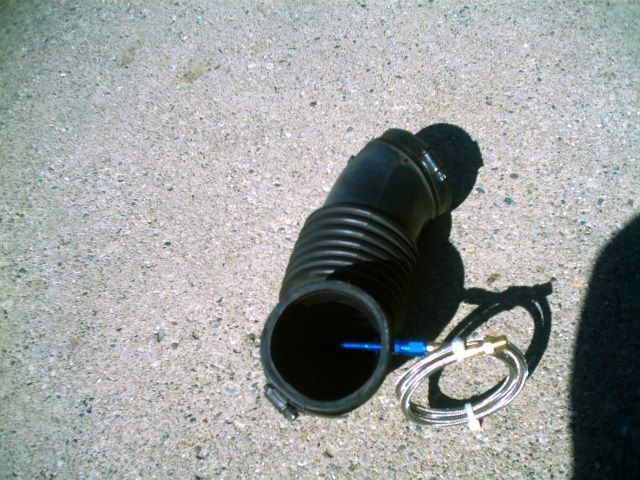
then drill all the way through the tb, then tap the tb
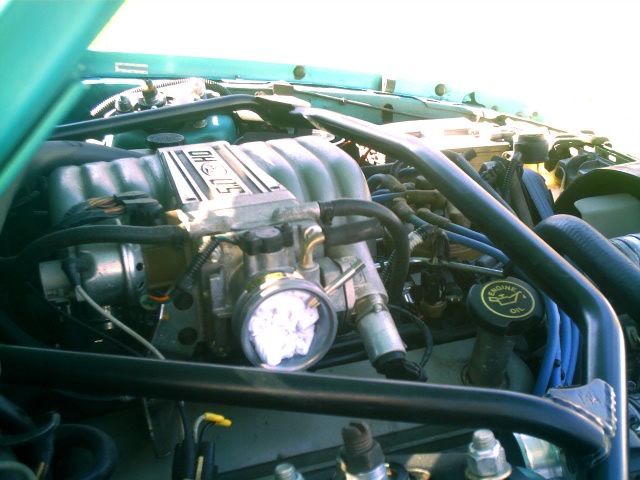
mount the selonoids and reg wherever, run the nozzle line to the nozzle
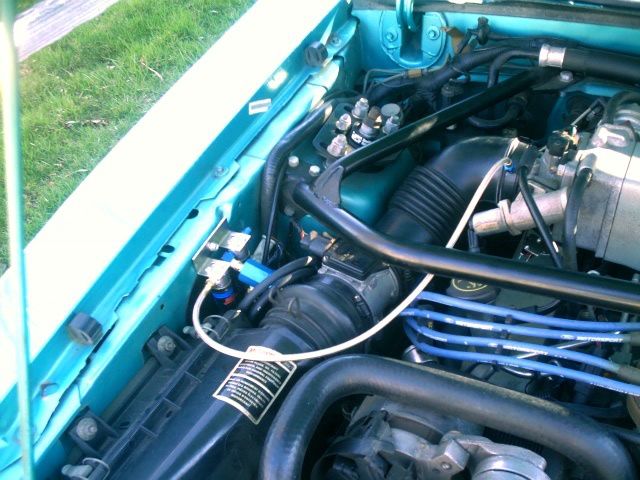
you can mount the bottle brackets by putting the bottle in the brackets, marking the holes, drilling pilot holes , and then using large self-tapping sheet metal bolts to secure it in
pull the rubber plug in the trunk, and run the feed line through it, it will drop out in the frame rail
run it along the frame rail, frame ties and zip tie it to the fuel line if nothing else available
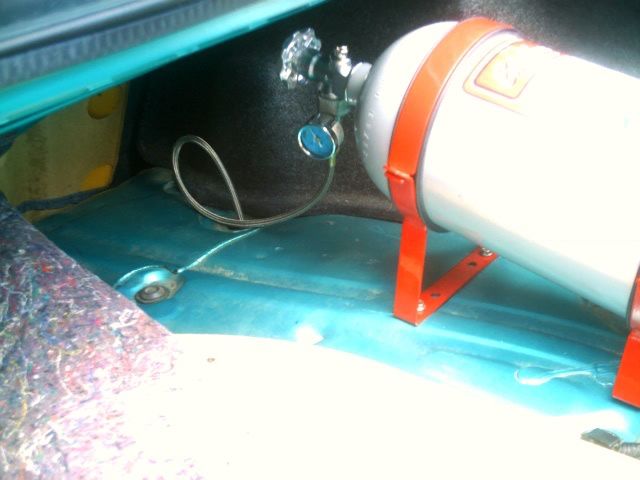
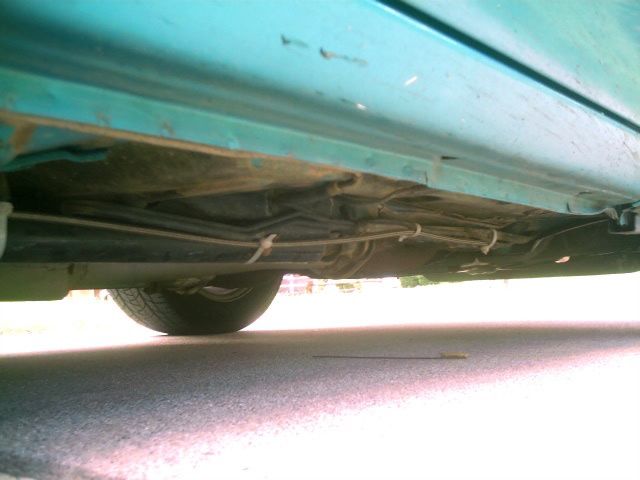
if you slice the carpet right, it will go back in place
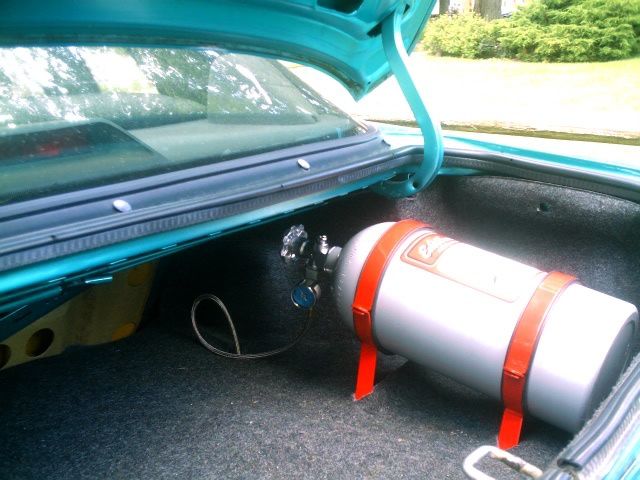
i mount the switch right here on the kick panel. then pick up power in the fuse box, w/ a spade in an open terminal
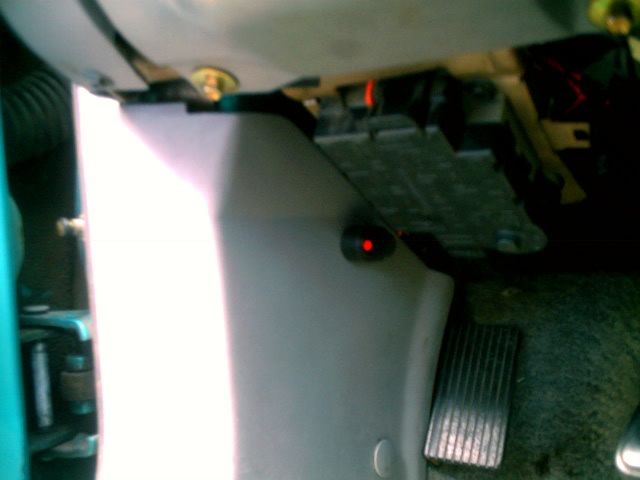
microswitch mounts right at the tb bolt that is the lower and towards the front of the car
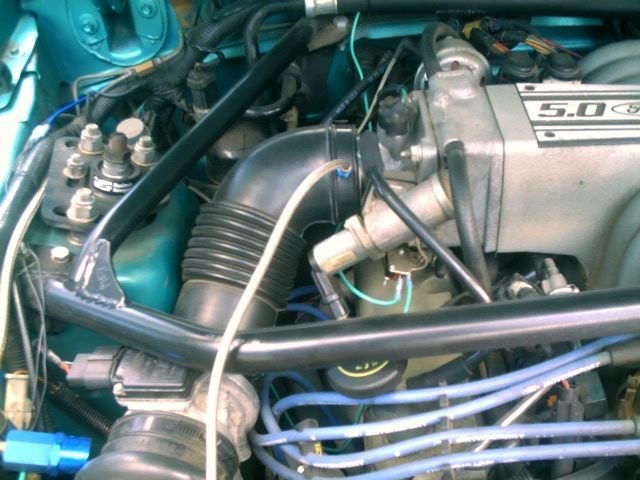
the relay can go wherever...i put it right here, and run the power to the battery
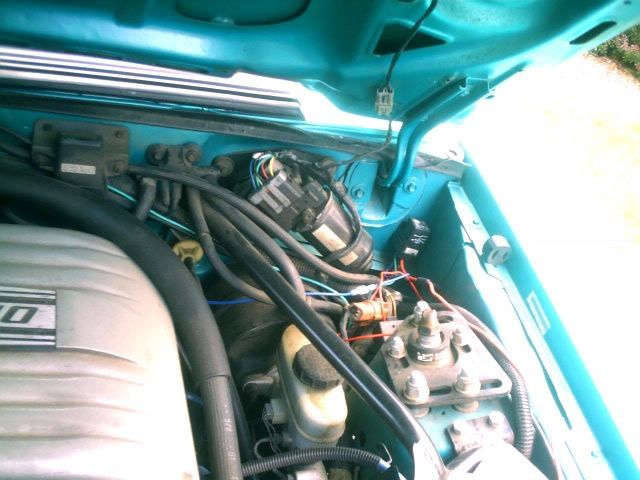
Stuff a rag in the tb like this, drill a hole in the clamp (make sure the nozzle will fit through easily)

then drill all the way through the tb, then tap the tb

mount the selonoids and reg wherever, run the nozzle line to the nozzle

you can mount the bottle brackets by putting the bottle in the brackets, marking the holes, drilling pilot holes , and then using large self-tapping sheet metal bolts to secure it in
pull the rubber plug in the trunk, and run the feed line through it, it will drop out in the frame rail
run it along the frame rail, frame ties and zip tie it to the fuel line if nothing else available


if you slice the carpet right, it will go back in place

i mount the switch right here on the kick panel. then pick up power in the fuse box, w/ a spade in an open terminal

microswitch mounts right at the tb bolt that is the lower and towards the front of the car

the relay can go wherever...i put it right here, and run the power to the battery

#4
Why haven't I seen this section before!?
B O O S T !!!
Here's how my Zex install
http://www.glovesandclover.com/tutor...kit/index.html
B O O S T !!!
Here's how my Zex install
http://www.glovesandclover.com/tutor...kit/index.html
#5
Just to add a small point that people often forget. Nitrous oxide is released fromthe bottle at an approximate -125 degrees. with that cold injection into the engine you will now have a much denser fuel charge. The colder the air the more gas you can fit into the same spot. Nitrous oxide does provide a much higher oxygen count right out of the bottle and also nitrous is a magnet for oxygen. If you release one molecule of nitrous you find that there will be 10 time the amount of oxygen being attracted to it. Which is also a big part of why tuning is so critical.
#7
#9
#10
id go with a wet kit. personally. Zex and Nitrous express to name a few make some very user friendly kits. Wet kits IMO are alittle safer cause you aint going to go lean as easy. On stock new style 5.0 your good up to a 100 shot. If you go larger i would drop down to a colder plug. Also i definietly recommend using a low fuel pressure cut off switch. ans some guys like Window switches too. Also as you up the hp hit rec upping your fuel octane to help control detonation. Also get a good tune done. These motors will take 200 shot safely if set up properly.
Thread
Thread Starter
Forum
Replies
Last Post
kawiguy827
5.0L GT S550 Tech
0
09-01-2015 07:09 PM



